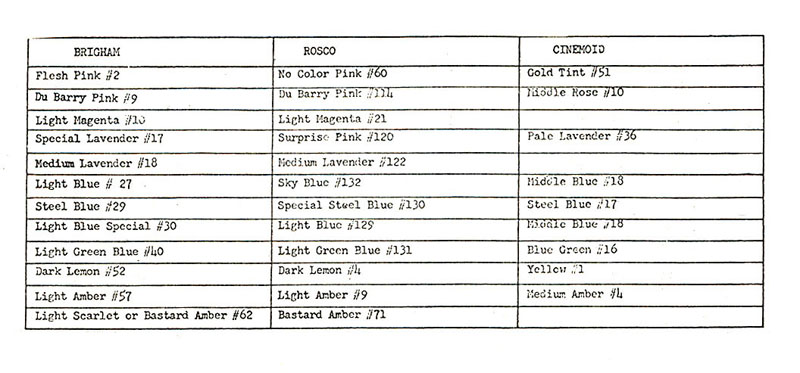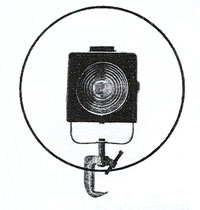

BY TOM SKELTON
courtesy of
Dance Magazine
first published
July 1956
TOOLS OF LIGHTING DESIGN: COLORED LIGHT ON PIGMENT
To understand how colored light will affect the colored pigment of your costumes and make-up, it is necessary to understand that two different process of color mixing are involved:
Subtractive
When you mix paint or dyes, you know that red and yellow make orange, that red and blue make magenta and that blue and green make blue-green:
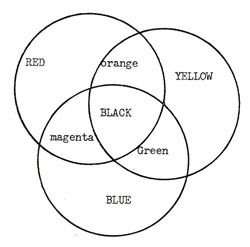
This is called subtractive color mixing, since the pigments cancel each other out and all of the primaries together produce black, the absence of all color. Without going into too much detail, we find that red, yellow and blue are the primary colors of pigment. When they are mixed in various proportions they can produce any other color. But a tint can be produced only by adding white.
Additive
When you turn two colored lights onto a white surface, red and green make yellow, green and blue make blue-green and blue and red make magenta:
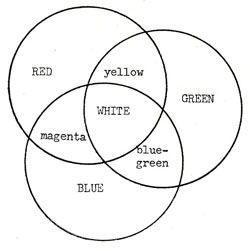
This is called additive color mixing, since one color is added to another to produced a third. The primaries are red, blue and green, and when added together they produce white light, the presence of all color. To produce a tint you add the complimentary color. Pink, for instance, is red plus a little blue and a little green. A secondary color like yellow (50% red and 50% green) can be made pale yellow, ivory or white simply by adding blue.
Pigment
Pigment, whether it be the costume or make-up, can be seen only because it reflects the light that shines on it. But it will not reflect all colors indiscriminately. It will reflect only the color that both the light and the pigment have in common. A green costume under red light will turn black because green dye is composed of yellow and blue dye, neither of which can reflect red light. But the same green costume will become very yellowish under yellow light and very bluish under blue light since it can be sympathetic to both yellow and blue.
Pink light is a tint of red light since it has a little blue and a little green in it. The green costume under pink light will still be green, but will be a slightly darker shade than natural because some of the blue and yellow pigment will turn black.
To spare you the necessity of figuring out how colored light will affect your costumes, here is a chart. Remember that with rich colors (primaries and secondaries) the pigment will “appear” to be the color that is common to both light and the pigment. And remember, also, that a tint of colored light will change but not destroy the pigment color since the tint is composed of some of all three additive primaries.
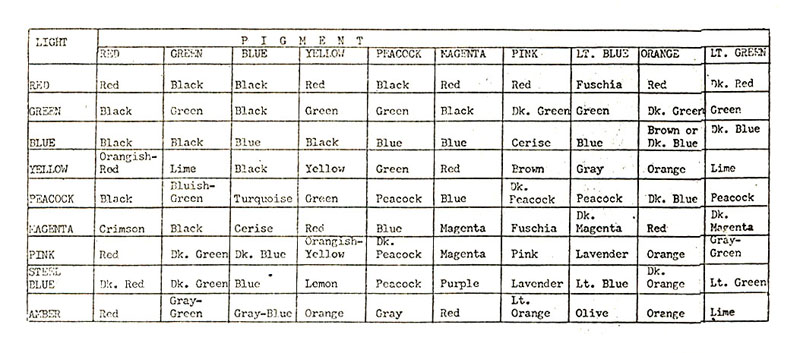
Colored light will affect make-up in the same way that it affects the pigments in the chart above. But since make-up distortion can be so much more subtly harmful I think a more detailed chart would be helpful. This chart deals only with the light tints that you are apt to use for general lighting, since the richer more dramatic colors are used primarily for effects and are generally used in conjunction with tints to provide the actual illumination.
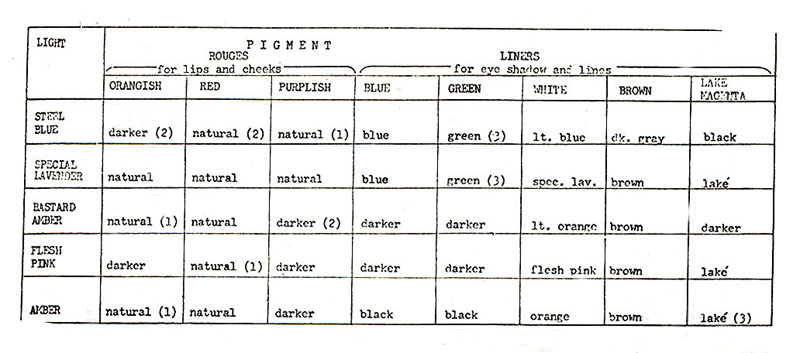
(1) use a little more of it than you might ordinarily use (Natural means that pigment color will not be changed by light color.) |
These charts are useful only up to a certain point, as anyone who has ever tried to dye a costume can tell you. The impurity of pigments often misleads you as to what the actual color is composed of. Words like “purplish,” furthermore, mean such different things to different people. But I hope these charts will serve as an advisory guide when you are planning costumes and make-up. They should show you that green costumes and eye-shadow may not come across in their natural color unless the lighting makes special concessions to the pigment color. Conversely, the distortion of color caused by using the wrong color of light often produces stunning and unexpected colors. Steel blue light on a yellow costume results in an irridescent [sic] lemon. Magenta light on a red costume produces a bright crimson and on an orange costume makes the brightest of reds. In another instance you may want to “kill” the costume color. The potential is unlimited for color emphasis or de-emphasis.
P.S. While we’re doing charts, here is one that may help you when you order your gelatine. Each of the three major manufacturers of gelatine use different names and numbers for the products, so this chart is intended to help you figure out which color you want, depending on the manufacturer from whom you order. Some of the Brigham colors are not matched by Rosco or Cinemoid, and even those that are matched are sometimes only approximate. (All of these colors were discussed in the January ’56 issue of DANCE Magazine.)
(Cont. next month)
